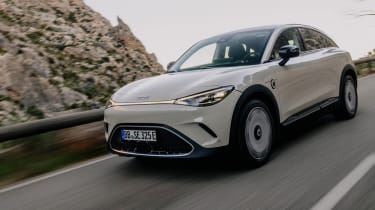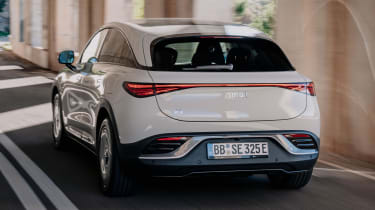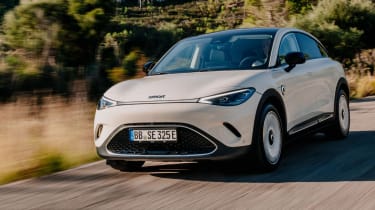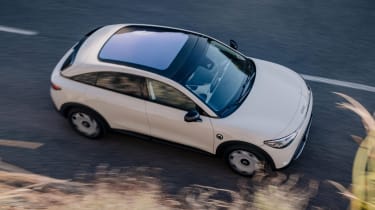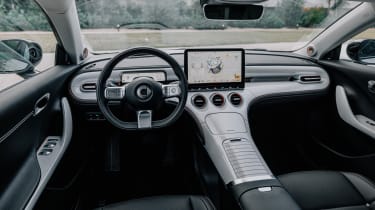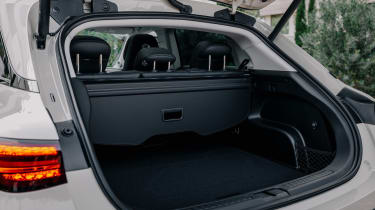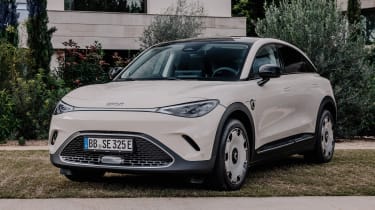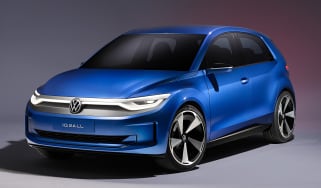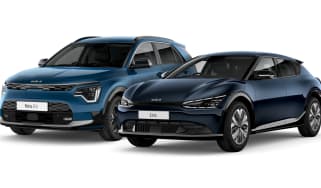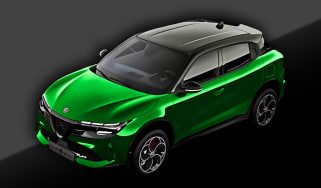Smart #3 review: a compact coupe-SUV with Big Brother watching
It may have its faults, but the Smart #3 is a stylish and likeable coupe-SUV with a peppy electric motor and a long equipment list
Smart #3 verdict
Smart has done the clever thing and listened to customer feedback when developing the #3. This mid-size coupe-SUV shares many of its parts with the #1 but Smart’s driver assistance systems are now less nannying - even if they do still tend to badger you a little more than we’d like.
The Smart #3 also feels a little more grown-up to drive than the #1. As in the #1, the rear-mounted electric motor offers plenty of performance but stiffer suspension makes the #3 feel more composed overall. With only a £1,500 price difference and slightly smaller boot to consider, we’re quick to recommend the sportier-looking #3 over the boxier #1 and think it's a good left-field option if you’re hoping to stand out in the sea of Tesla Model Ys.
Details, specs and alternatives
Smart has long been famous – or infamous, depending on who you ask – for building cars that place fashion above usability. The new Smart #3, on the other hand, promises to deliver both stylish looks, as well as everyday practicality, all thanks to its coupe-SUV form factor.
Rakish coupe SUVs are all the rage at the moment – especially in the electrified segment of the market, given how their slippery shapes tend to benefit range and efficiency. Pinned to start from under £40,000 when it goes on sale in the UK, Smart’s entry into the ring will have a long list of strong, if mostly larger and more expensive rivals. These include the Volvo C40, BMW iX2, Cupra Tavascan, Volkswagen ID.5 and the top-selling Tesla Model Y.
Unlike the smaller Smart #1, the #3 will be available with three powertrains at launch; entry-level cars get a pretty potent 268bhp electric motor on the rear axle, which is powered by a 49kWh battery pack. This results in a 0-62mph time of 5.8 seconds and an electric range of 202 miles. Step up to Pro+ model and you get a larger 62kWh battery for an increased range of 283 miles and the same 5.8-second 0-62mph time.
If this isn’t fast enough for you, there’s also the high-performance Brabus model which gets an extra electric motor on the front axle for a combined four-wheel-drive and 422bhp. Acceleration is just as rapid as you’d expect – 0-62mph takes just 3.7 seconds – however, the price you’ll pay for this is a slightly reduced range of 258 miles.
The standard Smart #3 will be available in four trim levels at launch: Pro, Pro+, Premium and Anniversary Edition. Standard kit is strong, with all Pro cars getting the 49kWh battery, LED headlights, 19-inch wheels, a 12.8-inch touchscreen, dual-zone climate control, heated front seats, a panoramic glass roof, a powered bootlid, a 360-degree camera and the brand’s ‘Smart Pilot’ driver assistance system at no extra cost.
Step up to the Pro+ and this nets you the larger 62kWh battery, electric leather seats and a wireless smartphone charger – this is our pick of the line-up. Premium cars take things a step further with a head-up display, an upgraded Beats sound system, a heat pump, autonomous parking and ambient lighting, but we wouldn’t spend the extra cash.

For a limited time after launch, Smart will also be offering a 25th Anniversary Edition that features a plethora of red accents and exclusive badging. Finally, the range-topping Brabus also gets red accents, as well as a more aggressive bodykit and 20-inch alloys.
Range, battery size & charging
|
Model |
Range |
Wallbox charge time |
Rapid charge |
|
49kWh |
202 miles |
7hrs 30mins (0-100%, 7.4kW) |
>30mins (10-80%, 130kW) |
|
62kWh |
283 miles |
12hrs 45mins (0-100%, 7.4kW) |
>30mins (10-80%, 150kW) |
|
Brabus |
258 miles |
12hrs 45mins (0-100%, 7.4kW) |
>30mins (10-80%, 150kW) |
The majority of Smart #3s get the same 62kWh battery that also features in the smaller Smart #1. However, the #3 is also available with an entry-level 49kWh battery which offers a range of up to 202 miles – we’d steer clear of this, unless you solely plan to drive the #3 around town.
Thanks to the #3’s slipperier shape, 62kWh models have a slightly longer range than the #1; Smart says you can expect a range of up to 283 miles – 10 miles farther than the equivalent #1 – while the #3 Brabus is able to do 258 miles before needing to be plugged-in.
Of course, these figures are just estimates – we doubt you’ll get at all close to the Brabus model’s claimed range figure if you don’t resist making use of all the power that’s on offer. We managed to return an average of 3.8 miles per kilowatt-hour on our test drive of the 62kWh model, which translates to a range of about 235 miles – 50 miles down on Smart’s claim. Top models do get a heat pump, which should help you get close to the headline stats in winter months, though.
When the battery does eventually run dry, the Smart #3 can rapid charge at speeds of up to 150kW; find a suitable public charger and this means a 10-80% top-up of the battery in under 30 minutes – even in the base car which maxes out at 130kW. Of course, if you’re using a home wallbox, it’ll take significantly longer; our estimate is just under 13 hours for a full charge for cars with the 62kWh battery.
Running costs & insurance
While pricing is yet to be revealed, we expect the Smart #3 to undercut other electric coupe-SUVs on the market, sitting more in-line price-wise with the likes of the smaller Jeep Avenger and Peugeot E-2008. This, combined with the usual savings you can expect from EV ownership means the Smart #3 will be an appealing proposition to those who appreciate value-for-money above all else.
Something to bear in mind is that while the Smart’s electric powertrain will save company car drivers cash thanks to its 2% Benefit-in-Kind rating, and everyone else a few pennies thanks to its zero rating for VED (road tax), the sheer amount of power that it offers means the #3 will be expensive to insure. If the Smart #1 is anything to go by, you can expect the coupe-SUV to occupy insurance groups in the mid thirties, perhaps even higher. While this is more than most rivals, a Tesla Model Y spans the top groups 48-50 and will demand even higher premiums.
Performance, motor & drive
|
Model |
0-62mph |
Top speed |
Driven wheels |
Power |
|
49kWh |
5.8s |
112mph |
Rear |
278bhp |
|
62kWh |
5.8s |
112mph |
Rear |
278bhp |
|
Brabus |
3.7s |
112mph |
Four |
422bhp |
Don’t let the Smart #3’s performance figures or sleek shape fool you: this is not a driver’s car. Don’t get us wrong, the point-and-squirt performance in even the base rear-wheel-drive model is intoxicating, let alone the ballistic manner of the top-of-the-line Brabus, but the #3 is better on a straight than through the corners. The throttle can be a bit too keen for our liking; strangely, we found flicking the car out of ‘Eco’ or ‘Normal’ mode into ‘Sport’ solved this issue somewhat, actually making responses more predictable.
Smart has gone a way to making the #3 feel a little keener to drive than the #1, though. A lower driving position and slightly stiffer suspension make the car seem a bit more composed, and body control remains pretty taut. We won’t give our full verdict on ride comfort until we get the car back in the UK, but the #3 felt pretty smooth on the roads of Majorca. That being said, the #3’s steering was too numb for you to accurately gauge the level of grip, meaning the front end can feel a little disconnected from the steering wheel when you’re on a twisty road.
Another qualm we have is regarding the Smart #3’s regenerative braking setup. There’s a disconcerting delay between you lifting off the accelerator and the regenerative braking kicking in, meaning it’s difficult to get accustomed to. This problem remains even in the strongest ‘E-Pedal’ setting which still doesn’t slow the car down enough to enable full one-pedal driving.
Interior, dashboard & infotainment
The Smart #’3s interior is as smart, clean and modern as its exterior; it’s very light, thanks to the standard-fit glass roof, and it’s clear Smart has certainly been rummaging in the bin when it comes to the #3’ switchgear – thankfully, though, it’s the Mercedes-Benz parts bin, which means the majority of what you touch feels suitably premium. There are a few bits of flimsy and nasty-feeling bits of trim, though, notably the centre console storage lid which would look right at home in a cheap flat-pack kitchen.
As is customary nowadays, most of the Smart’s controls centre around a large touchscreen mounted on the dashboard; this can be a bit fiddly to use given how cluttered many of the menus are, but we’re sure muscle memory will kick-in after a while and you’ll quickly be able to find what you need. That being said, if you can’t get your head around Smart’s software and its accompanying virtual assistant fox, the #3 does come as standard with Apple CarPlay and Android Auto.
Our real issue lies with Smart’s Big Brother-esque driver assistance system. We say ‘driver assistance’, but what we really mean is ‘driver surveillance’ as it does have a tendency to immediately start beeping at you whenever you take your eyes off the road – even if just to turn your head at a junction or take a drink of water. Don’t get us wrong, it’s less strict than the setup in the Smart #1, but pretty frustrating nonetheless.
Boot space, seating & practicality
|
Length |
Width |
Height |
Boot space (seats up/down) |
|
4,440mm |
1,844mm |
1,556mm |
370/1,160 litres |
The Smart #3, despite sharing its underpinnings with the #1 and Volvo EX30, is quite a bit larger than both of those cars. This means that despite the sloping roofline, the sacrifices in practicality over Smart’s other SUV model aren’t quite as drastic as you might expect; there’s plenty of space to seat two adults in the back, while the flat floor means an occasional third passenger will have room for their feet.
With a capacity of 370 litres, the #3’s boot appears, at face value, to be quite a bit smaller than the #1’s 411-litre load area. In practice, however, the usable space on offer is roughly the same, with sufficient room for the weekly shop or a couple of cabin bags for a weekend away.
Reliability & safety rating
The Smart #3 and its smaller sibling, the #1, both sit on all-new underpinnings, so it’s pretty hard to gauge reliability at this stage. What we can say is that electric cars should, in theory, be more reliable than their petrol and diesel counterparts due to having fewer moving parts to go wrong. Smart offers the #3 with a three-year, 30,000-mile comprehensive service package as standard, which includes all maintenance, while the battery pack is covered separately for up to eight years and 125,000 miles.
Euro NCAP recently awarded the Smart #1 with a full five-star safety rating in its increasingly stringent tests, and we’d be surprised if it doesn’t do the same for the #3. All Smart #3 models come as standard with safety equipment including that rather over-sensitive fatigue-detection camera, autonomous emergency braking (AEB), adaptive cruise control and automatic high beams.
